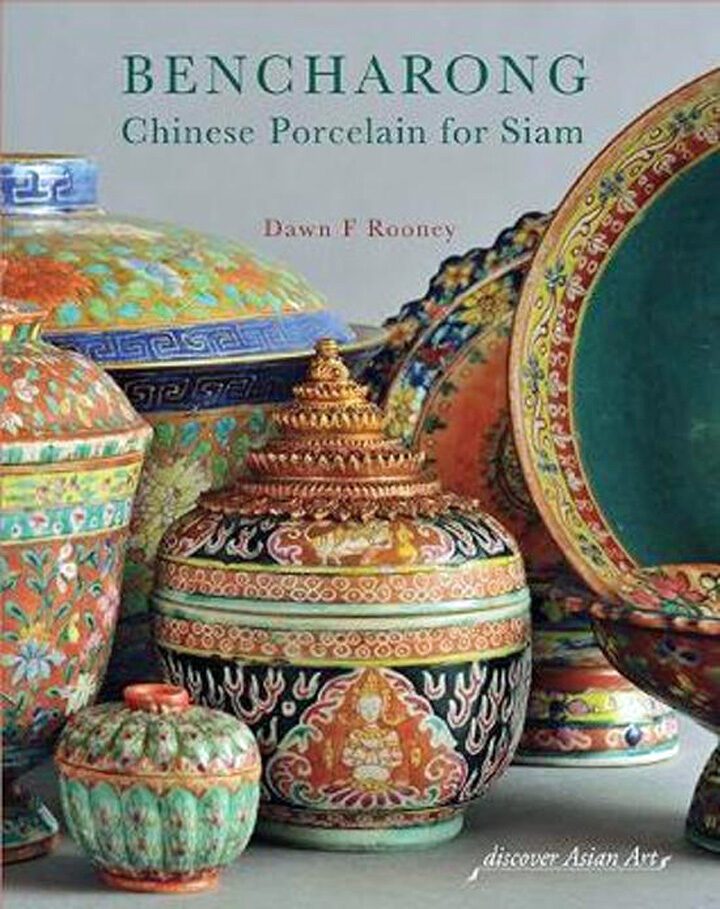Book review: Bencharong Chinese porcelain for Siam

About the origin of this porcelain hardly anything is known with certainty. It seems that the earliest traces of what later became known as Bencharong porcelain can be found in China during the short-lived reign of the fifth Ming emperor Xuande (1425-1435). One of the few historical records is that it originated in Zheijang province on the East China Sea and became popular under the reign of Emperor Chenghua (1464-1487). Legend has it that a Chinese princess was married off to a Siamese king and introduced this fine porcelain to the Siamese court in Ayutthaya. Perhaps Bencharong was first in Ayutthaya used in the court of Prasat Thong (1629-1656). The almost kaleidoscopic range of colors and folkloric-religious motifs made Bencharong very popular and it was not long before large orders were placed in China.
Originally it remained a product that was produced exclusively for the Siamese monarchs, but towards the end of the nineteenth century it also appeared in the homes of high court dignitaries, leading officials and the rapidly gaining power of Sino-Siamese traders. In any case, there is also evidence that Bencharong porcelain was produced in the second half of the nineteenth century – in limited editions – for use in the royal courts of Laos and Cambodia. Bencharong porcelain had many uses, from refined dining at royal tables to decorative temple objects and sophisticated tea drinking to spittoons, spittoons for betel chewers.
The name Bencharong is derived from Sanskrit and a compound of the words pancha (five) and ranga (to colour). But the number of colors on this porcelain did not necessarily have to be five and could go up to eight. Only the purest Chinese porcelain was used as a basis, Bone china, which was baked for hours at a constant temperature between 1150 and 1280 °. The decorative motifs – often geometric or inspired by flora – were then applied by hand in mineral colors and re-fired per color group at temperatures between 750 and 850°, a process that could take up to 10 hours. These lower temperatures were absolutely necessary to prevent the applied enamel from burning… One in Siam a very popular variant was the Lai Nam Thong porcelain, literally 'washed in gold', where the colorful motifs were accentuated by the application of gold. The knowledge required for the very labour-intensive production of this refined porcelain was limited to a few small artisan communities in the Canton area and was passed down from generation to generation, preserving its exclusive character.
The application of the colors and enameling was usually done in the kilns of the southern Chinese Canton, but there is evidence that this also happened occasionally in Bangkok later on. For example, it is certain that in 1880 Prince Bovornvichaichan had an oven built in the Bovorn Sathanmongkoi Palace in which Lai Nam Thong was produced. He ordered white porcelain from China, which was decorated in Bangkok and colored with traditional Thai motifs. For this, Chinese craftsmen were brought over to the Thai capital. A few years later, Phraya Suthonphimol had a kiln built for glazing Bencharong.
Precisely dating Bencharong porcelain is a tricky task. From the earliest period, which roughly coincides with the last century and a half of the Ayutthaya era, hardly any relevant dating material remains. As far as I know, no scientifically based catalog was ever drawn up, which certainly didn't make dating any easier. The most interesting pieces are usually situated between the last quarter of the eighteenth and the beginning of the twentieth century. Of exceptional quality and consequently now highly sought after, is the porcelain produced during the reign of Rama II (1809-1824).
With the fall of the imperial dynasty in China and the rapidly gaining popularity of Western dining sets, the traditional production of this porcelain came to an end shortly after the First World War. The Bencharong-like products that you find in the major shopping malls today are modern replicas, which, although well made, cannot stand comparison with the original.
Although Bencharong can be situated in the historically broader mass production of luxurious Chinese export porcelain and pottery for the European market in particular, as the author illustrates this with verve, it is undeniably Siamese or Thai in style and formal language. The numerous beautiful photographs in the book, many of which have never been published before, not only illustrate the exceptional craftsmanship and beauty of this product, but also testify to this perfect marriage between the ancient technical prowess of Chinese porcelain makers and Thai aesthetics. For anyone who wants to know more about this intriguing piece of Chinese-Siamese porcelain history, this book is a beautiful and, above all, well-founded introduction.
Bencharong: Chinese porcelain for Siam is published by River Books in Bangkok and has 219 pages.
ISBN: 978-6167339689


When buying for about 10 years at: https://www.thaibenjarong.com/
River City Shopping Complex 3rd.Floor, room No.325-326
23 Drew Rongnamkaeng, Yotha Road, Sampantawong, Bangkok 10100
(Near Royal Orchid Sheraton Hotel)
Phone/Fax: 66-2-639-0716
No tourist “rubbish” but high-quality products. Substrate (if applicable) 18 karat gold and then hand-painted. Alice (or her family) will receive you with warmth. By the way this whole complex is worth to visit. Not too big, but a small paradise for art and antique lovers.
We bought a lot there years ago in different stages, of course. Tea cups, rice bowls, etc. was not cheap. But luckily all still intact